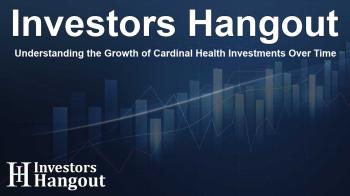Understanding the Growth of Cardinal Health Investments Over Time

Exploring Cardinal Health’s Investment Growth
Cardinal Health (NYSE: CAH) has shown remarkable resilience in the stock market, achieving a significant annualized return of 27.8% over the past five years. Investors who chose Cardinal Health during this period have seen their portfolios thrive, with the company recently boasting a market cap of $38.46 billion.
The Impact of Compounded Returns
To put it in perspective, if an investor had put $100 into Cardinal Health five years ago, their investment would now be worth approximately $337.06. This impressive growth underscores the power of compounded returns, which highlights how the money can substantially increase when reinvested over time.
Comparative Market Performance
When looking at other stocks within the healthcare sector, Cardinal Health's performance stands out. While many companies typically oscillate, CAH has exceeded average market performance by 12.91%, contributing to its reputation as a solid investment choice.
Key Insights From Cardinal Health’s Performance
Investing in Cardinal Health has proven to enrich its investors significantly over the years. The jump from an initial investment to its current value clearly demonstrates how a well-chosen stock can outperform others in the market and deliver outstanding value. The lesson here is twofold: understanding market dynamics and choosing the right company are critical for long-term success.
Future Prospects for Cardinal Health
As we reflect on Cardinal Health’s past performance, it's essential to consider what the future may hold for this healthcare giant. The company is poised for growth, focusing on innovations in healthcare distribution and technology enhancements. This forward-thinking approach could further bolster its market position, presenting new opportunities for investors.
Why Choose Cardinal Health?
Investors should consider Cardinal Health not only for its thriving stock performance but also for its strategic direction. The company's commitment to improving health outcomes and operational efficiencies speaks volumes about its future trajectory. Cardinal Health's evolving strategies will likely continue driving value for shareholders.
Frequently Asked Questions
How has Cardinal Health performed in the past five years?
Cardinal Health has achieved an annualized return of 27.8%, outperforming the market by 12.91%.
What is the current market capitalization of Cardinal Health?
The current market capitalization of Cardinal Health is approximately $38.46 billion.
If I invested $100 in CAH five years ago, what would it be worth today?
An investment of $100 in Cardinal Health five years ago would be worth about $337.06 today.
What factors contribute to Cardinal Health's stock performance?
Key factors include its strong market position, strategic acquisitions, and a commitment to innovation in healthcare.
What can we expect from Cardinal Health in the future?
With ongoing improvements and innovations in healthcare services, Cardinal Health is well-positioned for continued growth and success in the future.
About The Author
Contact Dylan Bailey privately here. Or send an email with ATTN: Dylan Bailey as the subject to contact@investorshangout.com.
About Investors Hangout
Investors Hangout is a leading online stock forum for financial discussion and learning, offering a wide range of free tools and resources. It draws in traders of all levels, who exchange market knowledge, investigate trading tactics, and keep an eye on industry developments in real time. Featuring financial articles, stock message boards, quotes, charts, company profiles, and live news updates. Through cooperative learning and a wealth of informational resources, it helps users from novices creating their first portfolios to experts honing their techniques. Join Investors Hangout today: https://investorshangout.com/
The content of this article is based on factual, publicly available information and does not represent legal, financial, or investment advice. Investors Hangout does not offer financial advice, and the author is not a licensed financial advisor. Consult a qualified advisor before making any financial or investment decisions based on this article. This article should not be considered advice to purchase, sell, or hold any securities or other investments. If any of the material provided here is inaccurate, please contact us for corrections.

